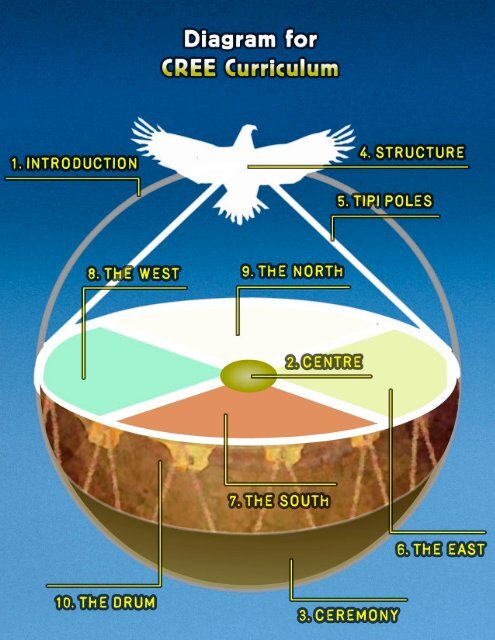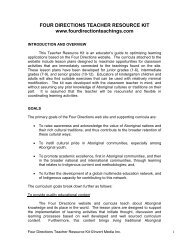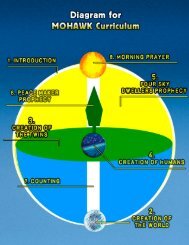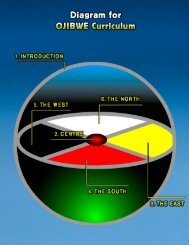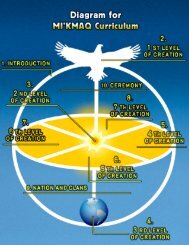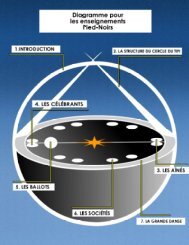cree (nehiyawak) teaching - Four Directions Teachings.com
cree (nehiyawak) teaching - Four Directions Teachings.com
cree (nehiyawak) teaching - Four Directions Teachings.com
- No tags were found...
You also want an ePaper? Increase the reach of your titles
YUMPU automatically turns print PDFs into web optimized ePapers that Google loves.
still has room. And if you put it up right, the poles never show on the bottom, andthat tipi stands with dignity, just as, years ago, women always covered their legswith the skirt, which also represents the sacred circle of life. And when you putthe flaps up, it teaches you how we embrace life itself. It’s like a woman standingthere with her arms out, saying “Thank you” to everything.That is what the tipi is - it is the spirit and body of woman, because sherepresents the foundation of family and <strong>com</strong>munity. It is through her that welearn the values that bring balance into our lives. That is why, when youconstruct a tipi, it involves ceremony: because the ceremony of making a tipirepresents the value of women’s <strong>teaching</strong>s.TIPI CEREMONYWhen I make something, it’s not just to make it; it’s got meaning to it. It’s likewhen I pick sweetgrass, and when I braid it, there’s a prayer that goes in there.Whoever I give that sweetgrass to, when they burn it, those prayers <strong>com</strong>e out,and they help that person.It’s the same with a tipi. When I make a tipi, when it goes up the first time, it hasto face the east, because a tipi to me is not just a symbol, it’s a ceremony.The doorway is very important in ceremony. For ceremonial purposes, the Creeface the doorway east because that represents the beginning of creation.Today, people forget that. That is why, when I am asked to make a tipi forsomeone, I take them through the ceremony so that they can embrace the truemeaning and <strong>teaching</strong> of the tipi. I hope that it is a way to touch their spirit andprovide guidance for them on their journey.Before making a tipi, I offer tobacco. I don’t just stand and let that tobacco fall; Isit on the ground with humbleness, because I am offering something forsomething I will use from Mother Earth. Because it’s not ours; everything wetake is borrowed; we’re borrowing time; we’re borrowing all the things we need tomake a tipi.I also ask whoever I am building the tipi with to offer tobacco with humbleness. Iusually ask the women in that family to offer the tobacco, because the tipi is awoman’s symbol; and the ceremony is a woman’s <strong>teaching</strong>. The men can bepart of the ceremony and can help to put up a tipi but they can’t hold the<strong>teaching</strong>s, because they are not women. The men need the women to bepresent during the making of the tipi to take in those <strong>teaching</strong>s and to offer thatsacred tobacco to Mother Earth because that is all part of the ceremony.I learned this through doing it, and through the instruction of my mother, whotaught me that tobacco must be given for each stage of the process. So when I© 2006 All Rights Reserved 4D Interactive Inc.
go out to the land and cut down the tipi poles, I make offerings of tobacco eachtime. This is how we honour the resources and gifts of our Mother Earth. Shehas gifted us for a very long time.Today, people use tipis more or less for symbolic reasons. But I have made the<strong>com</strong>mitment to share the <strong>teaching</strong>s of the tipi each time I put one up. I do thisbecause the tipi is a ceremony that reminds us of the balance we must bring toour lives and of the powerful <strong>teaching</strong>s that the women have.TIPI STRUCTUREToday I make tipis that stand twenty-two feet high, but years ago, tipis weremaybe twelve or thirteen feet. They didn’t have the material for large structuresbecause they used hide instead of canvas and rocks instead of ground pegs.That is why today you can still find circles of rocks, or tipi rings, on the land. Itwouldn’t make sense to have your tipi too high, because the winds and stormswould catch it.As time passed, the rocks were replaced with chokecherry ground pegs becausethey were one of the harder woods once they were dry. Today I cut and peelspruce for the tipi poles and I use sticks to adjust the front flaps of the tipientryway. My mother used a bone from the moose leg to close the tipi in thefront.My mother never used a measuring tape, or mapped things out mathematically –she just cut out her tipi and made it. And each time it was perfect.The Cree people use 15 poles to make the structure of the tipi. For every pole inthat tipi, there is a <strong>teaching</strong>. So there are 15 <strong>teaching</strong>s that hold up the tipi.Other Nations use 16 poles, and maybe more, I don’t know. All I know is what Iknow I was taught and that is the <strong>teaching</strong>s for 15 poles.The tipi does not have to face east all the time; it can rotate in any direction. It isonly the first time that I request that the tipi face east, because of the openingceremony.To start, we take three poles and bind them together to make a tripod. Each polealso has a very specific meaning. These three together fortify the structure.They are obedience, respect and humility. Notice the poles, the way they stand.If they stood straight up and down, they couldn’t support a tipi. But balancedproperly together, they are able to reinforce each other. There’s a <strong>teaching</strong> inthat. In order to make a family, you need three: the two parents and the child, tomake that balance.The tops of the poles have many <strong>teaching</strong>s. Each one points in a differentdirection. We are like those poles. We all need the strength and support of our© 2006 All Rights Reserved 4D Interactive Inc.
families and <strong>com</strong>munities, but we accept that we all have different journeys andpoint in different directions.The poles also teach us that no matter what version of the Great Spirit webelieve in, we still go to the same Creator from those many directions and beliefsystems; we just have different journeys to get there. And where the poles <strong>com</strong>eout together at the top, it’s like they’re creating a nest. And they also resemble abird with its wings up when it <strong>com</strong>es to land, and that’s another <strong>teaching</strong>: thespirit <strong>com</strong>ing to land, holding its wings up.TIPI POLESWe could talk about each of these poles for a long time; each one holds many<strong>teaching</strong>s, and takes a long time and much experience to truly understand. I willgive you some words on each pole, to give a beginning idea of what the polesrepresent.EASTThe woman spirit <strong>com</strong>es from the east, where the sun rises, where our warmthand vision starts. And the spirit of women brings that warmth into the home.One of our four sacred medicines, sage, also resides here in the east, because itis women’s medicine. It <strong>com</strong>es from the buffalo plant that was gifted to thewomen. It is called prairie buffalo sage. There are many sacred <strong>teaching</strong>s aboutthe plants and medicines, and of how they decided to be where they are, but thatis another <strong>teaching</strong> for another time.Here in the east is the beginning of all life, when the spirit is conceived and giftedto the womb of the mother-to-be. And because that being is identified as aperson at conception, the older women taught us how to balance ourselvesduring that nine-month journey, how to look after ourselves so that journey wouldnot be disrupted. My mother would sit and talk with the young women, and themen too, about how to make that connection with that spirit, before the child waseven born. Because it hears your voice, has your emotions, feels your spiritualstate during that nine-month journey. She used to say, “Your child can heareverything you say, feels all your emotions.”My mother also taught how human life is conditioned in the first year. She calledit Eshkawasis, meaning “new child.” She stressed the importance of this firstyear - that the new chid’s journey in this time should be especially safe. Forexample, you would always carry your child with two hands, with the greatestrespect; you don’t carry such a special gift under one arm.© 2006 All Rights Reserved 4D Interactive Inc.
A newborn is very powerful, the greatest of all teachers. They can sense thingsthat are not the norm, and let you know, protect you spiritually. We call it having anightmare, but that’s not what it is. And they continue to teach us as they grow.For example, they will crawl, stand, fall down and get up again, and learn to walk.My mother used to say, “That child teaches you what life’s going to be - you don’tjust get up once and walk forever - you will fall, and you will have to get up.Maybe you’ll need to crawl a little bit, but you will get up and walk again.”She said, “look at that child, how they struggle. They teach us that we don’t giveup just because we fell. Even as they get older, they fall by playing. Again,that’s a reminder: we must always persist in getting up and doing things againand again.”My mother also taught us to give thanks to Mother Earth for accepting our childto walk upon her. When that time <strong>com</strong>es, a celebration feast happens, andElders <strong>com</strong>e and pray for that young person on the next stages of their journey.SOUTHHere in the south all life is active. It’s the time of summer. Our physical aspect isrepresented here. In this part of our journey, we be<strong>com</strong>e young people. Theyoung are very physical beings, very active, continuously moving, changingthemselves, even their moods. We have good energy at this time of our journey.A lot of people today are scared of youth; we don’t quite understand or trustthem. But there’s a reason why: we’ve kept them apart from that circle of life.We need to respect youth, and accept them into our world. In our Creelanguage, there’s no word for “teenagers.” They’re young adults. And we needto encourage youth. We don’t need to say, “You’re bad,” because there are nobad people; we only do bad things.But sometimes youth need to be reminded by the old people. And that’s okay. Inotice older people saying, “I can’t tell my grandchildren that, because they don’tbelieve me, they don’t listen; they think I’m wrong.” Say it anyway. Like mymother used to say, “You don’t hear everything today, but someday you will hearwhat’s been said. When you need it you will hear it.” So it’s good to take youngpeople to older people, to have them sit there and listen. Because they might beblocking out that day, but their spirit never blocks out; their spirit will take in theinformation.And we should take the youth to see different people. My mother used to say, “Ifyou only go to one elder all your life, you will only know what that one elderknows.” So expand your wings and learn. Go and listen. You might not agree,but hear how that person is <strong>teaching</strong>. Hear the <strong>teaching</strong>s from other nations, andremember yours. But don’t ever contradict or correct them. Only when you’re© 2006 All Rights Reserved 4D Interactive Inc.
asked do you share. Young people sometimes disrespect the Elders whenthey’re talking about stories and <strong>teaching</strong>s; they’re correcting them. But thatElder can only share with you what they’ve heard and what they remember.Maybe you heard it different, but that’s okay. If you listen, you’ll be richer,because now you’ve heard different sides of the story.WESTHere in the West is the time of adulthood, of responsibility. You’re responsible atthat time for other people. It’s also the parenting stage of your life journey whenyou have that bond with the child in the eastern direction.And most often we are so touched by our children that we want them to have abetter life than we have as adults.And those children teach us, help us to remember to go back and do things overand over again even when we fall. It’s never a smooth journey when you are anadult because you have a lot of responsibility. You’re responsible for the childrenthat you brought into this world. And once you’re a parent, you’re a parent for life.So at that time, thinking about those responsibilities, people tend to seek advicefrom older people and sometimes the emotions and stories from your childhoodexperience <strong>com</strong>e out at that time.That’s why that gift of emotion is also in the West with the adult. We can do ourown thinking and speak out more as adults we’re stronger, more capable, if wehave grown in a good way. And if we know we need to get healthy, that’s usuallywhen we <strong>com</strong>e out and talk about issues that have held us back in our journeysto be good people, to live a good life.It’s a time to let go of anger and disclose emotion because a lot of times emotionturns to anger and that’s when it’s no good. It can be very harmful. It’s better ifthe emotion turns into a release through crying, which is a good way. It is a timewhen you can process your emotions and no longer be afraid or shy, when youare brave enough to tell your story. If there’s anything we need to get rid of mostoften that’s when we do it on our adult journey because sometimes we keep ourmourning, our loses in family and life until that time when we realize we need tolet go if we’re going to have a healthy journey.And it often takes that long until we are adults to finally grow that way, when weare faced with great responsibilityNORTH© 2006 All Rights Reserved 4D Interactive Inc.
We started from the east, we went to the south, and in the emotion part we wentto the west in our journey. That’s like any ceremony we go to. We start ourceremonies in the east, and then we’ll finish in the northern direction, which is ourlife journey. We finish our journeys as older people in that direction - which is themental part of our journey.I think the mental part is there because we’re capable then to stop and think, andlook at our journeys and foresee the journeys of our people. Because we havethe capability to be mentally intact, to know a lot of things that are needed in our<strong>com</strong>munities, in our people. We have time to think; we’re not so rushed, not sophysical any more. We went through our emotional stage of life. Now we aresort of the thinking part of the <strong>com</strong>munity, of the family. We are the ones thatmake decisions for families. We’re supposed to be the brain people; if we’velooked after ourselves, we get to that stage in our journey.And in this place we also have that relationship with the youth – who are lookingto us from the south.And we’re in that stage for a certain amount of time. Then we go back intoinfancy. You often see old people starting to forget, starting to act like children.They need help to walk, to be fed. We go back into that spirit world of being aninfant one more time. In Aboriginal society that was accepted. When you see oldpeople go into that stage in their journey, beyond their mental capabilities andback into that infancy, spirit, they talk a lot about their childhood, remember it likeit happened today, remember those stories so vividly, but they won’t remembermuch about their adulthood or their youth. They’ll remember, because they’regoing back into that journey. My grandmother used to talk about how theyplayed and how they climbed trees. She was 92 years old and she would tell mestories about when she was little, being a child. Because she was going backinto being a child one more time.THE DRUMThere’s a <strong>teaching</strong> in the four directions of the Medicine Wheel aboutresponsibility and relationship between the four stages of life. This <strong>teaching</strong><strong>com</strong>es from the <strong>teaching</strong> of the drum, the circle that is the drum. When youcriss-cross the directions as you tie the drum, it shows how adults can parent aninfant because the tie goes from the child to the adult. And from there it goes tothe elder who is tied to the youth. That’s why it was gifted at the time of creationof human beings that the adults should parent that infant and that’s why Elderscan often speak to young people better than an adult that’s parenting that youngperson because that connection in the wheel is <strong>com</strong>ing from north to the south,from Elder to youth. It’s so so important today and a lot of times when the youngperson <strong>com</strong>es along in the southern door, that’s why then grandparents wereused to give <strong>teaching</strong>s at that time. Sometimes grandparents only took that child© 2006 All Rights Reserved 4D Interactive Inc.
for a year or two, sometimes longer. The dominant society never understoodwhen a young person was moved to the grandparents. It wasn’t because theparents couldn’t parent, they just knew that cycle of <strong>teaching</strong> in the fourdirections. It’s in the Medicine Wheel. Our lives are like the Medicine Wheel – allour motion, our life, our journeys are in the Medicine Wheel. That’s how the<strong>teaching</strong>s happened years ago.TIPI POLESOBEDIENCEObedience means accepting guidance and wisdom from outside of ourselves,using our ears before our mouth. We learn by listening to traditional stories, bylistening to our parents or guardians, our fellow students and our teachers. Welearn by their behaviors and reminders, so that we know what is right and what iswrong.RESPECTRespect means giving honor to our Elders and fellow students, to the strangersthat <strong>com</strong>e to visit our <strong>com</strong>munity, and to all of life. We must honor the basicrights of all others.HUMILITYWe are not above or below others in the circle of life. We feel humbled when weunderstand our relationship with Creation. We are so small <strong>com</strong>pared to themajestic expanse of Creation, just a “strand in the web of life.” Understandingthis helps us to respect and value life.HAPPINESSAfter the tripod is up, the fourth pole <strong>com</strong>pletes your doorway. This fourth poleteaches us happiness. We must show some enthusiasm to encourage others.Our good actions will make our ancestors happy in the next world. This is howwe share happiness.LOVEIf we are to live in harmony we must accept one another as we are, and acceptothers who are not in our circle. Love means to be good and kind to one anotherand to our selves.FAITHWe must learn to believe and trust others, to believe in a power greater thanourselves, whom we worship and who gives us strength to be a worthy memberof the human race. To sustain our spirituality, we need to walk it every day. Notjust sometimes, but every day. It’s not just once a week; it’s your life.KINSHIP© 2006 All Rights Reserved 4D Interactive Inc.
Our family is important to us. This includes our parents, brothers and sisters,who love us and give us roots that tie us to the lifeblood of the earth. It alsoincludes extended family: grandparents, aunts, uncles and cousins, and their inlawsand children. They are also our brothers and sisters and give us a sense ofbelonging to a <strong>com</strong>munity.CLEANLINESSToday when we talk about cleanliness, most people think hygiene, and that’svery important. But years ago, when old people talked about cleanliness, theymeant spiritual cleanliness. When I used to sit with the old Kookums in their tipis,spiritually, they were so powerfully clean. Clean thoughts <strong>com</strong>e from a cleanmind and this <strong>com</strong>es from our spirituality. With a clean mind and sense of peacewithin we learn not to inflict ills on others. Good health habits also reflect aclean mind.THANKFULNESSWe learn to give thanks: to always be thankful for the Creator’s bounty, which weare privileged to share with others, and for all the kind things others do for us.SHARINGWe learn to be part of a family and <strong>com</strong>munity by helping with the provisions offood and other basic needs. Through the sharing of responsibilities we learn thevalue of working together and enjoying the fruits of our labor.STRENGTHWe are not talking about physical strength, but spiritual strength. That wasinstilled in us when we were young people through fasting. We must learn to bepatient in times of trouble and not to <strong>com</strong>plain but to endure and showunderstanding. We must accept difficulties and tragedies so that we may giveothers strength to accept their own difficulties and tragedies.GOOD CHILD REARINGChildren are gifts from the Creator. We are responsible for their wellbeing,spiritually, emotionally, physically, and intellectually, since they are blessed withthe gift of representing the continuing circle of life, which we perceive to be theCreator’s will.HOPEWe must look forward to moving toward good things. We need to have a sensethat the seeds we are planting will bear fruit for our children, families and<strong>com</strong>munities.ULTIMATE PROTECTION© 2006 All Rights Reserved 4D Interactive Inc.
This is the ultimate responsibility to achieve the balance and well being of thebody, mind, emotions and spirit for the individual, the family, the <strong>com</strong>munity andthe nation.CONTROL FLAPSThe control flaps on a tipi teach that we are all connected by relationship and thatwe depend on each other. Having respect for and understanding this connectioncreates and controls harmony and balance in the circle of life. When we don’tknow how to use the flaps, it gets all smoky inside the tipi, and you can’t see,which is like life – because if we can’t live in balance, we can’t see clearly wherewe’re going.CONCLUSION - POLESFor every time that a pole is added, a rope goes around to bind that pole intoplace. You have to be there and see it to appreciate that <strong>teaching</strong>. That rope is asacred bond, binding all the <strong>teaching</strong>s together until they are all connected.I have shared these <strong>teaching</strong>s with you with the hope that they will help keep thewomen strong and will help our <strong>com</strong>munities to nurture healthy, balanced people.© 2006 All Rights Reserved 4D Interactive Inc.


